凯撒密码
1. 介绍
凯撒密码作为一种最为古老的对称加密体制,在古罗马的时候都已经很流行,他的基本思想是:通过把字母移动一定的位数来实现加密和解密。明文中的所有字母都在字母表上向后(或向前)按照一个固定数目进行偏移后被替换成密文。例如,当偏移量是3 的时候,所有的字母A 将被替换成D,B 变成E,由此可见,位数就是凯撒密码加密和解密的密钥。
例如:字符串”ABC”的每个字符都右移3 位则变成”DEF”,解密的时候”DEF”的每个字符左移3 位即能还原,如下图所示:
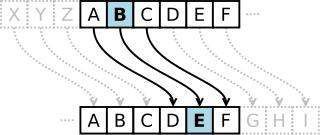
2. 准备知识
//字符转换成ASCII 码数值 char charA = 'a'; int intA = charA; //char 强转为int 即得到对应的ASCII 码值,'a'的值为97 //ASCII 码值转成char int intA = 97;//97 对应的ASCII 码'a' char charA = (char) intA; //int 值强转为char 即得到对应的ASCII 字符,即'a'
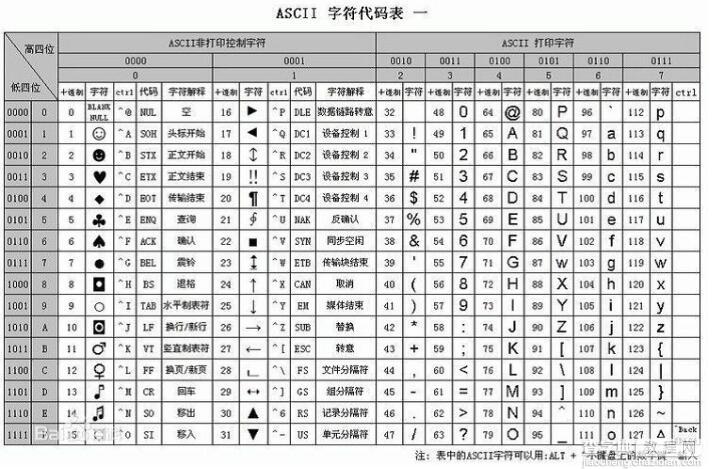
3. 凯撒密码的简单代码实现
/** * 加密 * @param input 数据源(需要加密的数据) * @param key 秘钥,即偏移量 * @return 返回加密后的数据 */ public static String encrypt(String input, int key) { //得到字符串里的每一个字符 char[] array = input.toCharArray(); for (int i = 0; i < array.length; ++i) { //字符转换成ASCII 码值 int ascii = array[i]; //字符偏移,例如a->b ascii = ascii + key; //ASCII 码值转换为char char newChar = (char) ascii; //替换原有字符 array[i] = newChar; //以上4 行代码可以简写为一行 //array[i] = (char) (array[i] + key); } //字符数组转换成String return new String(array); } /** * 解密 * @param input 数据源(被加密后的数据) * @param key 秘钥,即偏移量 * @return 返回解密后的数据 */ public static String decrypt(String input, int key) { //得到字符串里的每一个字符 char[] array = input.toCharArray(); for (int i = 0; i < array.length; ++i) { //字符转换成ASCII 码值 int ascii = array[i]; //恢复字符偏移,例如b->a ascii = ascii - key; //ASCII 码值转换为char char newChar = (char) ascii; //替换原有字符 array[i] = newChar; //以上4 行代码可以简写为一行 //array[i] = (char) (array[i] - key); } //字符数组转换成String return new String(array); }
代码输出结果:

4. 破解凯撒密码:频率分析法
凯撒密码加密强度太低,只需要用频度分析法即可破解。
在任何一种书面语言中,不同的字母或字母组合出现的频率各不相同。而且,对于以这种语言书写的任意一段文本,都具有大致相同的特征字母分布。比如,在英语中,字母E 出现的频率很高,而X 则出现得较少。
英语文本中典型的字母分布情况如下图所示:
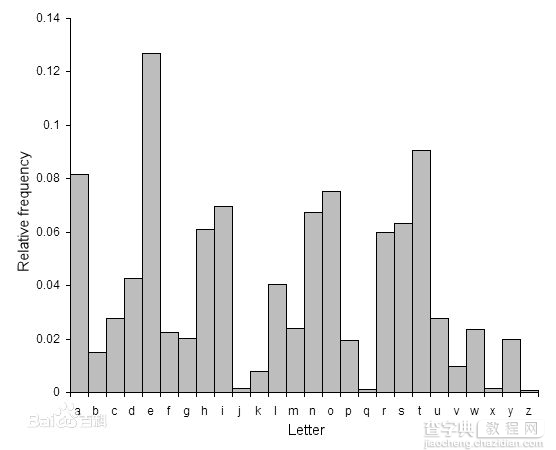
5. 破解流程
统计密文里出现次数最多的字符,例如出现次数最多的字符是是'h'。
计算字符'h'到'e'的偏移量,值为3,则表示原文偏移了3 个位置。
将密文所有字符恢复偏移3 个位置。
注意点:统计密文里出现次数最多的字符时,需多统计几个备选,因为最多的可能是空格或者其他字符,例如下图出现次数最多的字符'#'是空格加密后的字符,'h'才是'e'偏移后的值。

解密时要多几次尝试,因为不一定出现次数最多的字符就是我们想要的目标字符,如下图,第二次解密的结果才是正确的。
/** * 频率分析法破解凯撒密码 */ public class FrequencyAnalysis { //英文里出现次数最多的字符 private static final char MAGIC_CHAR = 'e'; //破解生成的最大文件数 private static final int DE_MAX_FILE = 4; public static void main(String[] args) throws Exception { //测试1,统计字符个数 //printCharCount("article1_en.txt"); //加密文件 //int key = 3; //encryptFile("article1.txt", "article1_en.txt", key); //读取加密后的文件 String artile = file2String("article1_en.txt"); //解密(会生成多个备选文件) decryptCaesarCode(artile, "article1_de.txt"); } public static void printCharCount(String path) throws IOException{ String data = file2String(path); List<Entry<Character, Integer>> mapList = getMaxCountChar(data); for (Entry<Character, Integer> entry : mapList) { //输出前几位的统计信息 System.out.println("字符'" + entry.getKey() + "'出现" + entry.getValue() + "次"); } } public static void encryptFile(String srcFile, String destFile, int key) throws IOException { String artile = file2String(srcFile); //加密文件 String encryptData = MyEncrypt.encrypt(artile, key); //保存加密后的文件 string2File(encryptData, destFile); } /** * 破解凯撒密码 * @param input 数据源 * @return 返回解密后的数据 */ public static void decryptCaesarCode(String input, String destPath) { int deCount = 0;//当前解密生成的备选文件数 //获取出现频率最高的字符信息(出现次数越多越靠前) List<Entry<Character, Integer>> mapList = getMaxCountChar(input); for (Entry<Character, Integer> entry : mapList) { //限制解密文件备选数 if (deCount >= DE_MAX_FILE) { break; } //输出前几位的统计信息 System.out.println("字符'" + entry.getKey() + "'出现" + entry.getValue() + "次"); ++deCount; //出现次数最高的字符跟MAGIC_CHAR的偏移量即为秘钥 int key = entry.getKey() - MAGIC_CHAR; System.out.println("猜测key = " + key + ", 解密生成第" + deCount + "个备选文件" + "n"); String decrypt = MyEncrypt.decrypt(input, key); String fileName = "de_" + deCount + destPath; string2File(decrypt, fileName); } } //统计String里出现最多的字符 public static List<Entry<Character, Integer>> getMaxCountChar(String data) { Map<Character, Integer> map = new HashMap<Character, Integer>(); char[] array = data.toCharArray(); for (char c : array) { if(!map.containsKey(c)) { map.put(c, 1); }else{ Integer count = map.get(c); map.put(c, count + 1); } } //输出统计信息 /*for (Entry<Character, Integer> entry : map.entrySet()) { System.out.println(entry.getKey() + "出现" + entry.getValue() + "次"); }*/ //获取获取最大值 int maxCount = 0; for (Entry<Character, Integer> entry : map.entrySet()) { //不统计空格 if (/*entry.getKey() != ' ' && */entry.getValue() > maxCount) { maxCount = entry.getValue(); } } //map转换成list便于排序 List<Entry<Character, Integer>> mapList = new ArrayList<Map.Entry<Character,Integer>>(map.entrySet()); //根据字符出现次数排序 Collections.sort(mapList, new Comparator<Entry<Character, Integer>>(){ @Override public int compare(Entry<Character, Integer> o1, Entry<Character, Integer> o2) { return o2.getValue().compareTo(o1.getValue()); } }); return mapList; } public static String file2String(String path) throws IOException { FileReader reader = new FileReader(new File(path)); char[] buffer = new char[1024]; int len = -1; StringBuffer sb = new StringBuffer(); while ((len = reader.read(buffer)) != -1) { sb.append(buffer, 0, len); } return sb.toString(); } public static void string2File(String data, String path){ FileWriter writer = null; try { writer = new FileWriter(new File(path)); writer.write(data); } catch (Exception e) { e.printStackTrace(); }finally { if (writer != null) { try { writer.close(); } catch (IOException e) { e.printStackTrace(); } } } } }
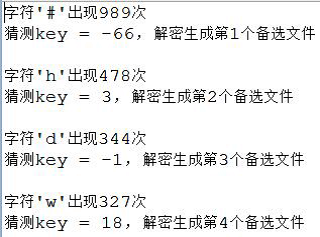
对称加密
介绍
加密和解密都使用同一把秘钥,这种加密方法称为对称加密,也称为单密钥加密。
简单理解为:加密解密都是同一把钥匙。
凯撒密码就属于对称加密,他的字符偏移量即为秘钥。
对称加密常用算法
AES、DES、3DES、TDEA、Blowfish、RC2、RC4、RC5、IDEA、SKIPJACK 等。
DES:全称为Data Encryption Standard,即数据加密标准,是一种使用密钥加密的块算法,1976 年被美国联邦政府的国家标准局确定为联邦资料处理标准(FIPS),随后在国际上广泛流传开来。
3DES:也叫Triple DES,是三重数据加密算法(TDEA,Triple Data Encryption Algorithm)块密码的通称。
它相当于是对每个数据块应用三次DES 加密算法。由于计算机运算能力的增强,原版DES 密码的密钥长度变得容易被暴力破解;3DES 即是设计用来提供一种相对简单的方法,即通过增加DES 的密钥长度来避免类似的攻击,而不是设计一种全新的块密码算法。
AES: 高级加密标准(英语:Advanced Encryption Standard,缩写:AES),在密码学中又称Rijndael 加密法,是美国联邦政府采用的一种区块加密标准。这个标准用来替代原先的DES,已经被多方分析且广为全世界所使用。经过五年的甄选流程,高级加密标准由美国国家标准与技术研究院(NIST)于2001 年11 月26 日发布于FIPS PUB 197,并在2002 年5 月26 日成为有效的标准。2006 年,高级加密标准已然成为对称密钥加密中最流行的算法之一。
DES 算法简介
DES 加密原理(对比特位进行操作,交换位置,异或等等,无需详细了解)
准备知识
Bit 是计算机最小的传输单位。以0 或1 来表示比特位的值
例如数字3 对应的二进制数据为:00000011
代码示例
int i = 97; String bit = Integer.toBinaryString(i); //输出:97 对应的二进制数据为: 1100001 System.out.println(i + "对应的二进制数据为: " + bit);
Byte 与Bit 区别
数据存储是以“字节”(Byte)为单位,数据传输是以大多是以“位”(bit,又名“比特”)为单位,一个位就代表一个0 或1(即二进制),每8 个位(bit,简写为b)组成一个字节(Byte,简写为B),是最小一级的信息单位。
Byte 的取值范围:
//byte 的取值范围:-128 到127 System.out.println(Byte.MIN_VALUE + "到" + Byte.MAX_VALUE);
即10000000 到01111111 之间,一个字节占8 个比特位
二进制转十进制图示:
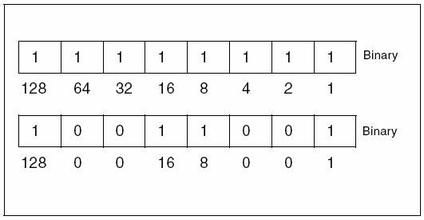
任何字符串都可以转换为字节数组
String data = "1234abcd"; byte[] bytes = data.getBytes();//内容为:49 50 51 52 97 98 99 100
上面数据49 50 51 52 97 98 99 100 对应的二进制数据(即比特位为):
00110001
00110010
00110011
00110100
01100001
01100010
01100011
01100100
将他们间距调大一点,可看做一个矩阵:
0 0 1 1 0 0 0 1
0 0 1 1 0 0 1 0
0 0 1 1 0 0 1 1
0 0 1 1 0 1 0 0
0 1 1 0 0 0 0 1
0 1 1 0 0 0 1 0
0 1 1 0 0 0 1 1
0 1 1 0 0 1 0 0
之后可对他们进行各种操作,例如交换位置、分割、异或运算等,常见的加密方式就是这样操作比特位的。
以上就是本文的全部内容,希望对大家的学习有所帮助,也希望大家多多支持查字典教程网。


